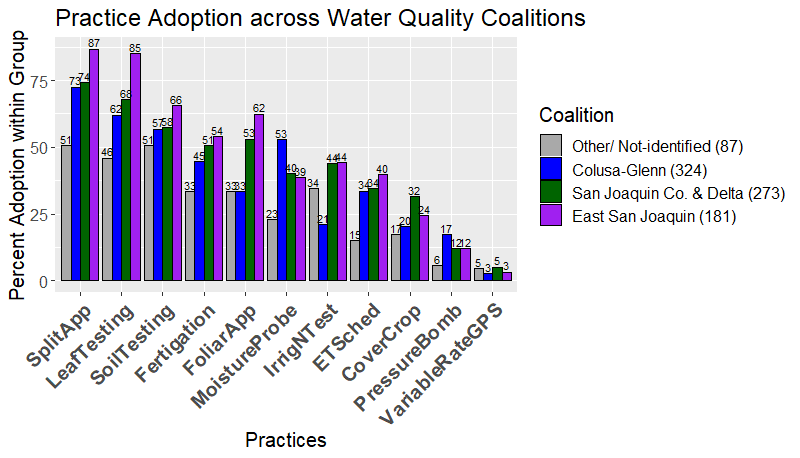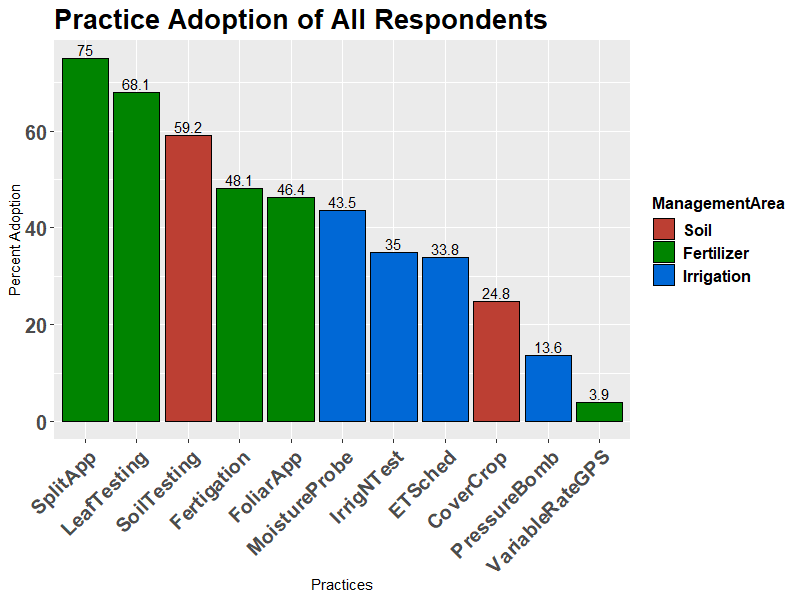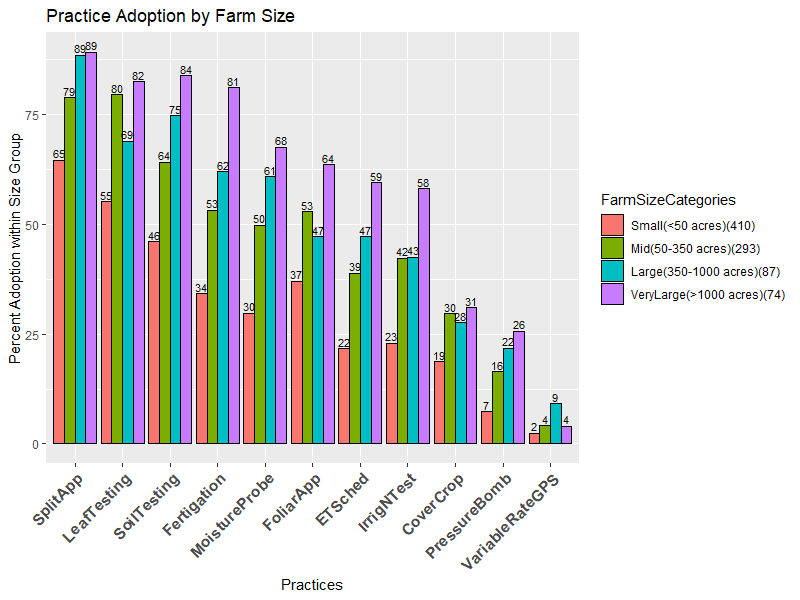Note: This is part of Research Update series that highlights projects funded by the California Department of Food and Agriculture (CDFA) Fertilizer Research and Education Program (FREP) (https://www.cdfa.ca.gov/is/ffldrs/frep/CompetitiveGrantProgram.html).
The first update on this project can be found here. (https://blogs.cdfa.ca.gov/FREP/index.php/research-update-understanding-grower-decisions/)
Project Title: Understanding Influences on Grower Decision-Making and Adoption of Improved Nitrogen Management Practices
Project Leaders: Mark N. Lubell, Jessica M. Rudnick, Sat Darshan S. Khalsa, Patrick H. Brown (University of California, Davis)
Project Status: Complete
Overview: This FREP-funded project provides baseline data on adoption rates of nitrogen (N) management practices in California’s Sacramento and San Joaquin Valleys and Delta regions. It also identifies behavioral drivers and constraints to adopting N management practices.
Background: California growers are being encouraged to adopt efficient N management practices to reduce risk of N movement into surface water and groundwater while maintaining economically viable cropping systems. Research over the past decade has identified many promising practices that can improve N management. Despite improvements in N management practices, the rate of practice adoption and barriers to adoption are not well understood. Thus, this project investigates possible factors influencing grower decision-making and identifies barriers to adoption in order to recommend potential incentives for practice adoption.
Approach: The researchers conducted semi-structured interviews with growers and water quality coalition representatives, hosted voluntary grower focus groups with real-time surveys and roundtable discussions, and designed a survey sent to ~5,000 growers by mail to assess social, political, and economic factors influencing decision making and adoption of N management practices. The researchers surveyed growers from the Colusa-Glenn Subwatershed Program (CGSP), San Joaquin County and Delta Water Quality Coalition (SJDWQC), and East San Joaquin Water Quality Coalition (ESJWQC). Throughout the project, the researchers engaged with many partners and stakeholders to identify appropriate data collection methods, ensure that survey questions were well-designed to answer stakeholders’ questions, and disseminated results to grower and stakeholder communities through outreach activities. They designed a survey data analysis method to determine key variables in each region that appear to influence adoption of practices.
Mail Survey Results: Across all coalitions, the management practices with the highest reported adoption rates were split N application, leaf testing, and soil testing (Figure 1). Higher overall adoption rates were observed for ESJWQC compared to CGSP and SJDWQC, respectively; however, ESJWQC had a lower response rate compared to the other two coalitions. Across all coalitions, there was higher adoption rate of fertilizer practices such as split application, leaf testing, and fertigation compared to irrigation practices (Figure 2). Across all coalitions, there was higher adoption by perennial crop operations compared to annual crop operations (Figure 3) and higher adoption by very large farms (>1000 acres) compared to small farms (<50 acres) (Figure 4). These effects may be the result of higher crop values of perennial crops such as fruits and nuts, compared to agronomic crops, which affords greater capacity to invest in new technologies. Furthermore, the longer-term nature of perennial crop production yields greater returns on investments realized over time. Similarly, higher adoption by larger farms suggests the role of economies of scale on practice adoption, where the costs associated with practice adoption can be more readily distributed over larger farms. The survey results also indicate that the most commonly used information resources among growers included a grower’s personal experience, Pest Control Advisers (PCAs), Certified Crop Advisers (CCAs), and other growers. However, preliminary surveys with PCA/CCAs, found that the primary information sources for these technical advisors included University of California Cooperative Extension, Natural Resources Conservation Service, and CDFA FREP, elucidating an important information chain from more central information sources to on-farm, individual consultants.
The researchers found that a range of barriers impact adoption, including cost, uncertainty, and lack of technical knowledge about the practice. Farming priorities that may motivate adoption include benefits to crop yield and crop quality, as well as soil fertility. It is important to understand how these management practices affect profitability of the farm, which is always a major focus for growers. Growers identified urban activities, livestock operations, and legacy agricultural leaching as more significant sources of water quality impacts, as compared to current agricultural practices. Acceptance of agriculture’s contribution to N pollution is found to be an important driver of increased practice adoption. Results also highlighted that growers report feeling a greater sense of control over on-farm N management, while they report less control over local water quality outcomes and associated regulations.




The survey results suggest that practices with a direct connection to fertilizer N management are more readily adopted by growers. Even though irrigation practices impact N leaching, a greater cognitive disconnect in the relationship with N management outcomes may contribute to lower adoption.
The researchers recommend the following based on their study results:
- The relationship between irrigation and N management needs to be better understood by farm consultants and growers alike.
- Focus N management outreach and education programs on PCA/CCAs, the most common and trusted information sources that growers refer to.
- Articulate goals of the regulatory program in a way that is relevant to growers.
- Reduce uncertainty around how the practices affect yield and farm profitability.
This study can provide valuable baseline data for the evolution of water quality policy decisions and on-going outreach and education activities by a large network of agriculture extension actors. The results from this work point to clear trends and consistent themes regarding the need to make policy, outreach, and future research decisions within the context of farmer behavior and the needs of farm operations.
Project Continuation: An extension to this project began in January 2019 to survey growers in the South San Joaquin Valley. Surveys will also be distributed to PCAs and CCAs to better understand their influence on the grower decision-making process and adoption of N management practices. Continue following the FREP blog for a research update on this project.


